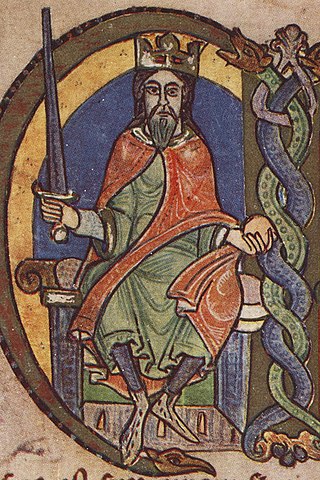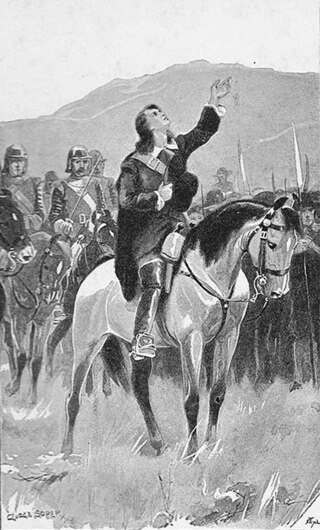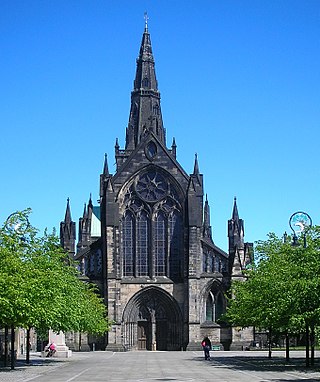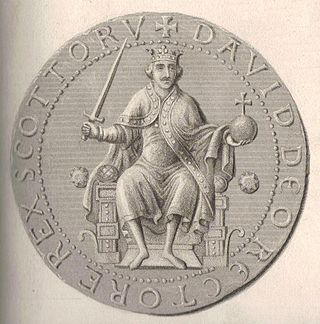Related Research Articles

Dunstan, OSB was an English bishop. He was successively Abbot of Glastonbury Abbey, Bishop of Worcester, Bishop of London and Archbishop of Canterbury, later canonised. His work restored monastic life in England and reformed the English Church. His 11th-century biographer Osbern, himself an artist and scribe, states that Dunstan was skilled in "making a picture and forming letters", as were other clergy of his age who reached senior rank. Dunstan served as an important minister of state to several English kings. He was the most popular saint in England for nearly two centuries, having gained fame for the many stories of his greatness, not least among which were those concerning his famed cunning in defeating the Devil.
Robert Baillie was a Church of Scotland minister who became famous as an author and a propagandist for the Covenanters.

David I or Dauíd mac Maíl Choluim was a 12th-century ruler who was Prince of the Cumbrians from 1113 to 1124 and later King of Scotland from 1124 to 1153. The youngest son of Malcolm III and Margaret of Wessex, David spent most of his childhood in Scotland, but was exiled to England temporarily in 1093. Perhaps after 1100, he became a dependent at the court of King Henry I of England. There he was influenced by the Norman-French culture of the court.

Archibald Campbell Tait was an Archbishop of Canterbury in the Church of England and theologian. He was the first Scottish Archbishop of Canterbury and thus, head of the Church of England.

Thomas Tenison was an English church leader, Archbishop of Canterbury from 1694 until his death. During his primacy, he crowned two British monarchs.

Richard Cameron was a leader of the militant Presbyterians, known as Covenanters, who resisted attempts by the Stuart monarchs to control the affairs of the Church of Scotland, acting through bishops. While attempting to revive the flagging fortunes of the Covenanting cause in 1680, he was tracked down by the authorities and killed in a clash of arms at Airds Moss in Ayrshire. His followers took his name as the Cameronians and ultimately formed the nucleus of the later Scottish regiment of the same name, the Cameronians. The regiment was disbanded in 1968.

Glasgow Cathedral is a parish church of the Church of Scotland in Glasgow, Scotland. It is the oldest cathedral in mainland Scotland and the oldest building in Glasgow. The cathedral was the seat of the Archbishop of Glasgow, and the mother church of the Archdiocese of Glasgow and the Province of Glasgow, until the Scottish Reformation in the 16th century. Glasgow Cathedral and St Magnus Cathedral in Orkney are the only medieval cathedrals in Scotland to have survived the Reformation virtually intact. The medieval Bishop's Castle stood to the west of the cathedral until 1789.

Robert Leighton was a Scottish prelate and scholar, best known as a church minister, Bishop of Dunblane, Archbishop of Glasgow, and Principal of the University of Edinburgh from 1653 to 1662. He was "noted for his Christian piety, his humility and gentleness, and his devotion to his calling".
The Bishop of Galloway, also called the Bishop of Whithorn, was the eccesiastical head of the Diocese of Galloway, said to have been founded by Saint Ninian in the mid-5th century. The subsequent Anglo-Saxon bishopric was founded in the late 7th century or early 8th century, and the first known bishop was one Pehthelm, "shield of the Picts". According to Anglo-Saxon ecclesiastical tradition, the bishopric was founded by Saint Ninian, a later corruption of the British name Uinniau or Irish Finian; although there is no contemporary evidence, it is quite likely that there had been a British or Hiberno-British bishopric before the Anglo-Saxon takeover. After Heathored, no bishop is known until the apparent resurrection of the diocese in the reign of King Fergus of Galloway. The bishops remained, uniquely for Scottish bishops, the suffragans of the Archbishop of York until 1359 when the pope released the bishopric from requiring metropolitan assent. James I formalised the admission of the diocese into the Scottish church on 26 August 1430 and just as all Scottish sees, Whithorn was to be accountable directly to the pope. The diocese was placed under the metropolitan jurisdiction of St Andrews on 17 August 1472 and then moved to the province of Glasgow on 9 January 1492. The diocese disappeared during the Scottish Reformation, but was recreated by the Catholic Church in 1878 with its cathedra at Dumfries, although it is now based at Ayr.
Christianity in Medieval Scotland includes all aspects of Christianity in the modern borders of Scotland in the Middle Ages. Christianity was probably introduced to what is now Lowland Scotland by Roman soldiers stationed in the north of the province of Britannia. After the collapse of Roman authority in the fifth century, Christianity is presumed to have survived among the British enclaves in the south of what is now Scotland, but retreated as the pagan Anglo-Saxons advanced. Scotland was largely converted by Irish missions associated with figures such as St Columba, from the fifth to the seventh centuries. These missions founded monastic institutions and collegiate churches that served large areas. Scholars have identified a distinctive form of Celtic Christianity, in which abbots were more significant than bishops, attitudes to clerical celibacy were more relaxed and there were significant differences in practice with Roman Christianity, particularly the form of tonsure and the method of calculating Easter, although most of these issues had been resolved by the mid-seventh century. After the reconversion of Scandinavian Scotland in the tenth century, Christianity under papal authority was the dominant religion of the kingdom.

The Bishop of St. Andrews was the ecclesiastical head of the Diocese of St Andrews in the Catholic Church and then, from 14 August 1472, as Archbishop of St Andrews, the Archdiocese of St Andrews.
Robert of Scone was a 12th-century bishop of Cell Rígmonaid. Robert's exact origins are unclear. He was an Augustinian canon at the Priory of St. Oswalds, at Nostell. His French name indicates a Norman rather than an Anglo-Saxon origin, but as he was likely born in the later 11th century, this may be due merely to the acculturation of his parents.
Jocelin was a twelfth-century Cistercian monk and cleric who became the fourth Abbot of Melrose before becoming Bishop of Glasgow, Scotland. He was probably born in the 1130s, and in his teenage years became a monk of Melrose Abbey. He rose in the service of Abbot Waltheof, and by the time of the short abbacy of Waltheof's successor Abbot William, Jocelin had become prior. Then in 1170 Jocelin himself became abbot, a position he held for four years. Jocelin was responsible for promoting the cult of the emerging Saint Waltheof, and in this had the support of Enguerrand, Bishop of Glasgow.
Robert Blackadder was a medieval Scottish cleric, diplomat and politician, who was abbot of Melrose, bishop-elect of Aberdeen and bishop of Glasgow; when the last was elevated to archiepiscopal status in 1492, he became the first ever archbishop of Glasgow. Archbishop Robert Blackadder died on 28 July 1508, while en route to Jerusalem on pilgrimage.

Historical treatment of David I and the Scottish church usually emphasises King David I of Scotland's pioneering role as the instrument of diocesan reorganisation and Norman penetration, beginning with the bishopric of Glasgow while David was Prince of the Cumbrians, and continuing further north after David acceded to the throne of Scotland. As well as this and his monastic patronage, focus too is usually given to his role as the defender of the Scottish church's independence from claims of overlordship by the Archbishop of York and the Archbishop of Canterbury.

Charles Petre Eyre (1817–1902) was a Roman Catholic clergyman who was appointed the first Roman Catholic archbishop of Glasgow since the Scottish Reformation. He served as archbishop from 1878 to 1902.

Gilbert was a 13th-century Cistercian monk, abbot and bishop. His first appearance in the sources occurs under the year 1233, for which year the Chronicle of Melrose reported that "Sir Gilbert, the abbot of Glenluce, resigned his office, in the chapter of Melrose; and there he made his profession". It is not clear why Gilbert really did resign the position of Abbot of Glenluce, head of Glenluce Abbey in Galloway, in order to become a mere brother at Melrose Abbey; nor is it clear for how long Gilbert had been abbot, though his latest known predecessor is attested last on 27 May 1222. After going to there, Gilbert became the Master of the Novices at Melrose.

Cum universi is a papal bull written by Pope Celestine III, issued on 13 March 1192. The bull ended the claim of the Archbishop of York to metropolitan jurisdiction in Scotland and established an independent national church, albeit one with no figurehead.

John Livingstone was a Scottish minister. He was the son of William Livingstone, minister of Kilsyth, and afterwards of Lanark, said to be a descendant of the fifth Lord Livingston. His mother was Agnes, daughter of Alexander Livingston, portioner, Falkirk, brother of the Laird of Belstane.
William Veitch. He was the youngest son of John Veitch, the minister of Roberton, Lanarkshire. He was educated at the University of Glasgow, graduating with an M.A. in 1659. He became a tutor in the family of Sir Andrew Ker of Greenhead. He was licensed to preach by the Presbytery of Lanark in 1664. Having identified himself with the Pentland Rising, he was outlawed, and escaped to Newcastle, where he became chaplain in the family of the Mayor. In 1671 he was ordained to a meeting-house at Fallowlees, a remote spot among the Simonside Hills, Rothbury. From that he removed to Hanamhall, in the same district, and afterwards to Seaton Hall, Longhorsly. Whilst living at the latter place under the assumed name of William [or George] Johnston, he was arrested on 16 January, and sentenced to the Bass Rock 22 February 1679.. Veitch was liberated on 17 July 1680, and returned to Newcastle. He aided Archibald, Earl of Argyll, in his escape from Scotland in 1681. In 1683 he went to Holland, and in 1685 he was again in Northumberland acting as an agent on behalf of Monmouth. Soon afterwards he was settled as minister of a meeting-house at Beverley, Yorkshire. Having returned to Scotland, he was called to Whitton Hall, Morebattle, April 1688. In 1690 he was minister of Peebles, and in September 1694, he was admitted to Dumfries. He demitted on 19 May 1715. His death was on 8 May 1722. In 1705 he presented to the church two communion cups.
References
- Anderson, Alan Orr, Scottish Annals from English Chroniclers: AD 500–1286, (London, 1908), republished, Marjorie Anderson (ed.) (Stamford, 1991), pp. 133–4
- Dowden, John, The Bishops of Scotland, ed. J. Maitland Thomson, (Glasgow, 1912), pp. 294–5